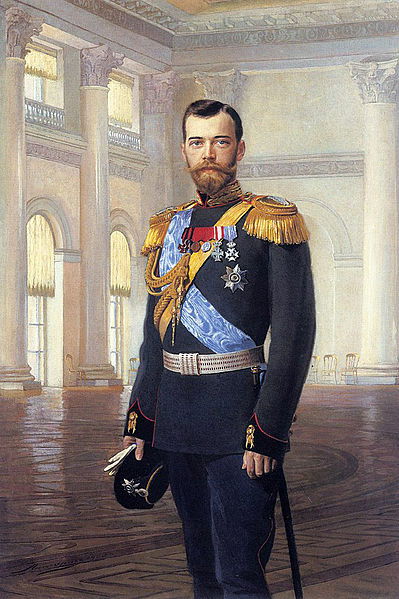The Murders at Ekaterinburg
Tsar Nicholas II and his family were murdered on July 17th, 1918.

Tsar Nicholas II of Russia abdicated after the February revolution of 1917. He and his immediate family were subsequently sent to Tobolsk in western Siberia, where they were humanely treated, but in the following year, after the Bolshevik takeover, they were moved to a house in Ekaterinburg, further south in the Urals. It had belonged to a merchant named Ipatiev. Five rooms on the upper floor were prepared for the seven members of the imperial family. The rest was used for guardrooms and offices, and the mansion was called 'the House of Special Purpose of the Ural Soviet Committee'.
Besides the tsar himself there were the tsarina, Alexandra Feodorovna (a German grand-daughter of Queen Victoria) and their five children: the thirteen-year-old tsarevitch Alexei, who suffered from haemophilia, could hardly walk and was mostly in a wheelchair; Olga and Tatiana in their early twenties; and the teenaged Marie and Anastasia. There were also a number of trusted servants, who had come with them from Tobolsk. The family were allowed walks in the garden, but were otherwise kept in their rooms. Gradually, the originally hostile guards began to like and grow close to their prisoners, but the civil war between Red and White Russians was raging and White armies were drawing close to Ekaterinburg.
This raised the prospect of the Romanovs being rescued and on July 4th the guards were suddenly replaced by a squad of Cheka secret police under the command of a certain Yakov Yurovsky. The Ural Soviet had sent to Moscow suggesting that Nicholas be executed. On July 12th they received word that the central regime would leave the fate of the prisoners in their hands. Yurovsky was informed and discovered an abandoned mine shaft some miles away from the town, where he hoped to hide the bodies. The prisoners sensed that something was up, and were uneasy.
At four in the afternoon of July 16th, the tsar and his daughters took a stroll in the garden. At 10.30pm they retired to bed, but three hours later they were woken and told to dress and come downstairs. Yurovsky told them that the Soviet had decided to move them because there was trouble in Ekaterinburg and asked them to wait in a small room until a truck arrived for them. Chairs were provided for some of them and four of their servants were brought in as well.
Yurovsky now came into the room with his Cheka squad, armed with revolvers, told the prisoners they had been sentenced to death, and shot Nicholas dead. The other guards immediately opened such a hail of fire that some of them were wounded in it. Tsarina Alexandra, Olga, Tatiana and Marie all fell dead, as did three of the servants. The fourth, the maid Anna Demidova, was sliced to pieces by bayonet thrusts. The terrified tsarevich, spattered with his father's blood, was shot, bayoneted and finally finished off with two shots from Yurovsky. Anastasia, the last Romanov alive, was bludgeoned with rifle butts and stabbed with bayonets.
The disposal of the bodies was a gruesome muddle. They were taken to the abandoned mine shaft in a truck and their clothes were burned on a bonfire before the corpses were dropped into a pool of water at the bottom of the shaft. It failed to conceal them and although some grenades were dropped into the shaft in an attempt to collapse it, the bodies had to be moved to a different shaft where sulphuric acid was used to destroy the faces, to prevent recognition. The second shaft also turned out to be inadequate and in the end Yurovsky's men dug a deep grave and the corpses were buried in it on July 19th.
Only six days later Ekaterinburg fell to White troops and officers went at once to the Ipatiev house. The execution room had been scrubbed, but there were bullet marks and bloodstains on the walls. In the following year the White regime in Siberia sent an investigator, Nicholas Sokolov, to Ekaterinburg. What had happened was common knowledge in the town; captured guards confessed and Sokolov found the first mine shaft with objects that had belonged to the family, but no bodies. They were not discovered until 1991, but two bodies were missing, thought to be those of Alexei and Anastasia (or Marie). Two bodies now known to be those of : Romanovs were subsequently found in another grave near Ekaterinburg, though there had long been speculation that they had somehow got away.
The reports that Anastasia was still alive were particularly persistent, and various people claimed to be her. The most famous of them was Anna Anderson, who said she had been left for dead among the others in the Ipatiev house, but rescued by a merciful guard. She died in the United States in 1984.




